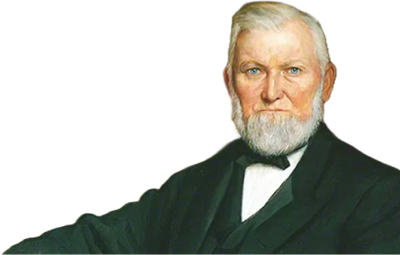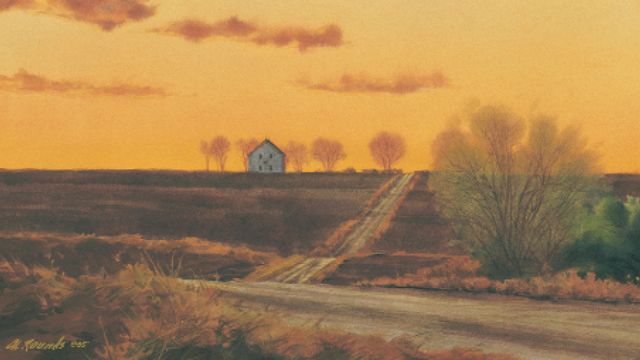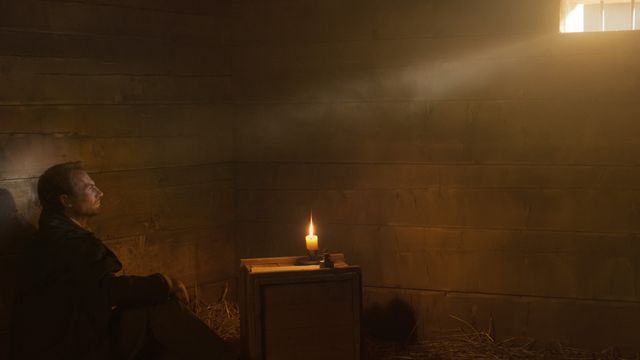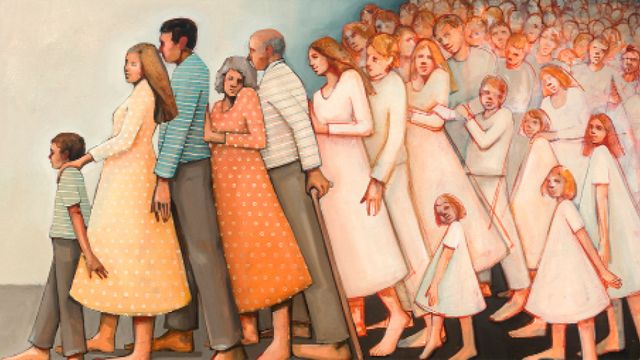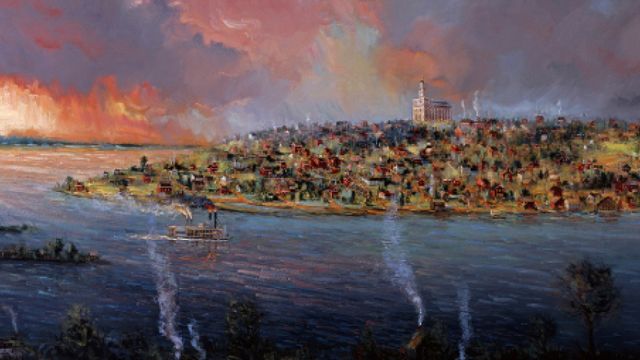

The development of temple doctrine in the nineteenth century can be traced through the life of one man: Wilford Woodruff. Indeed, his is the only life that spans the period from the introduction of temple ordinances through Joseph Smith in the 1830s to the revelations in 1890s that changed the focus of temple work to eternal families, as God intended.
Wilford not only witnessed the incremental development of temple ordinances and practices, he initiated some of the most significant changes in their implementation and administration. His desire to share the saving ordinances with his family members led him to seek additional insight regarding temple work.
Wilford’s experiences in Kirtland and Nauvoo prepared him for the revelations he received when he presided over the St. George Temple in the 1870s and when he served as prophet in the 1890s. Consequently, he implemented the inspired comprehensive and comprehensible system of ordinances for the salvation of the living and dead as God intended.
From his baptism into the Church in 1833 until his death in 1898, Wilford’s greatest desire was to share the opportunity for salvation with his extended family, both living and dead. He used expressions such as “glorious principles,” “merciful God,” and “joy unspeakable” when describing doctrinal developments. He thought no blessing given of God was equal to the privilege of entering the temple, receiving the ordinances for oneself, and administering them on behalf of others.
To facilitate the doctrinal developments and accomplish the mission of Elijah, Wilford built on Joseph Smith’s foundation within the framework constructed by Brigham Young and John Taylor. Thus, he was uniquely positioned to complete the work that Joseph Smith began as he was the only person intimately involved in all of the following:
- 1830s – introduction of ordinances for the living in Kirtland
- 1840s – development of ordinances for the salvation of both the living and dead
- 1850s-1860s – administration of some of those ordinances in the Council House and Endowment House
- 1877 – creation of the first written record of temple ceremonies and procedures
- 1877 – implementation of all the temple ordinances for both the living and the dead in the St. George Temple
- 1877 – receipt of revelations indicating who could serve as proxy and for whom proxy ordinances could be performed
- 1890s – receipt of revelations that led to the suspension of the practice of plural marriage and the replacement of priesthood adoptions with multi-generational family sealings.
The doctrinal foundation
At the time of his death in 1844, Joseph Smith was placing the final pieces in a doctrinal puzzle he had been assembling for 21-years. The basis for temple work had been established in 1823 when Moroni taught Joseph Smith about the mission of Elijah. Subsequent revelations about the salvation of those who died without a knowledge of the gospel and the conferral of the sealing power by Elijah in 1836 framed the additional pieces Joseph would be given in Nauvoo.
Between 1840 and 1843 Joseph Smith introduced the first proxy ordinance – baptism for the dead, as well as initiatory washing and anointing ordinances and the endowment ceremony for the living. These were followed by higher ordinances, including marriage sealings and further washings and anointings, for both the living and the dead. In May 1844 Joseph informed the apostles in the Quorum of Twelve that to save their deceased family and friends, they must vicariously receive all these ordinances for each person, the same as they had done for themselves.

The mission of Elijah
One month later – June 1844 – Joseph Smith was killed, before the implications of the doctrines could be realized and before the administration of all the ordinances for both the living and dead could begin.
- If today’s temple ordinances were limited to those Joseph Smith administered, the term “eternal families” would not be applicable.
- If temple practices and ordinances had remained unchanged from the time of Brigham Young’s death, the mission of Elijah could not have been fulfilled. We would be sealed through priesthood lineage rather than through family lineage.
- If the status quo when John Taylor died had been maintained, family sealings would have remained limited, the temples would have been seized by the United States’ government, and the Church as an entity may not have even survived.
It was Wilford Woodruff who implemented the plan of salvation and redemption of the dead outlined through revelation to Joseph Smith. Between 1877 and 1897, Wilford refined some temple ordinances and practices, modified others, and suspended or discontinued several more. He believed these inspired changes were necessary to fulfill the promises made to the fathers consistent with Elijah’s mission and thereby assist in God’s work “to bring to pass the … eternal life of man.” (Moses 1:39)

The St. George Temple
During the 31-year interim between the forced abandonment of the Nauvoo Temple in 1846 and the completion of the St. George Temple in 1877, membership in The Church of Jesus Christ of Latter-day Saints grew from about 16,000 to over 100,000. Only limited ordinances were allowed in the Council House and Endowment House in Salt Lake City during this time. Therefore, an entire generation passed away before they were able to complete the saving and exalting ordinances for their family members.
As Brigham Young’s health declined in the 1870s, he felt the same burden that Joseph Smith had felt in the 1840s: the necessity to instruct and properly train those who would carry on the work after his death. Brigham’s desire to fulfill this responsibility and the Saints’ concern for the salvation of their loved ones, led to the decision to build a temple in St. George rather than wait for the completion of the temple in Salt Lake.
Following the dedication of the St. George Temple on January 1, 1877, the long-anticipated ordinances were reintroduced, including sealings of children to parents and priesthood adoptions. However, it was the introduction of endowments for the dead that ushered in a new era and the rise of temple consciousness.
This expansion of ordinances broadened the circle of shared temple experience so, instead of only hearing the temple instruction once when receiving their own endowment, all those who returned to serve as proxies would hear the temple ceremonies repeatedly. The opportunity to contemplate the meaning of the ordinances resulted in a greater appreciation for their significance.
Revelations in 1877
Shortly after the Temple’s partial dedication on January 1, 1877, Brigham Young asked Wilford to preside over the day-to-day operations and administration of the ordinances. Wilford felt the weight of his responsibility for the only place on earth where the Saints could administer all the saving ordinances for both the living and the dead. For the next eight months, Wilford dedicated himself to this work, sometimes spending seven days a week in the Temple. Referring to this intense period, Wilford said, “the Lord … stirred up our minds, and … revealed to us [many things] concerning the dead.” (Journal of Discourses, 19:229.)
During this time, Wilford had three significant experiences that led to the transformation of temple work.
1- The First Written Record – Prior to 1877, the temple ceremonies had been taught verbally and then recited from memory when those who had received the ordinances officiated for others. On January 14, 1877, Brigham Young asked several men, including Wilford, to help him make a written record of temple ceremonies and procedures to ensure the consistent and correct administration of the ordinances.
This was unchartered territory and the journals of these men document the meetings held to review the day’s labor, address questions or issues that had arisen, and make necessary adjustments. Of this experience Wilford said the Lord made manifest His will whenever “light was desired,” giving revelations to His servants upon points of doctrine they did not understand. (Deseret News Weekly, 42:18, April 25, 1891, 554.) On March 21, 1877, Brigham Young pronounced their work complete.
2- Acting as proxy for the relatives of others – The second transformative experience Wilford had in 1877 was a result of his profound desire to vicariously perform temple ordinances for his deceased family members.
Wilford’s journals chronicle 30 years of effort to research his family history. By 1877 he had gathered information on more than 3,000 relatives. However, because his family members had not accompanied him to St. George, he wondered how he could single-handedly complete all the saving ordinances for these ancestors. On February 23, with this subject “resting on his mind,” he asked God how to accomplish the work. In response to his prayer, the Lord told him to call upon the Saints in St. George and let them officiate for him in that temple. In his journal he wrote of the great joy he felt as a result: “Light burst upon my understanding. I saw an effectual door open to me for the redemption of my dead.” (Wilford Woodruff’s Journal, March 1, 1877.)
The following week, with Brigham Young’s approval, Wilford invited 154 women to assist him in completing the ordinances for his female relatives. Wilford later explained, “This is a revelation to us. We can help one another in these matters if we have not relatives sufficient to carry this on, and it will be acceptable unto the Lord.” (Millennial Star 56, May 28, 1894, 339-341.) It is noteworthy that this revelation came to Wilford – one of the apostles – rather than Brigham Young, who was the Prophet and President of the Church.
Although acting as proxy for the relatives of others is now common practice in temples, it was a novel idea at the time. It expanded the possible scope of temple work by providing the means for all to participate. Even those who were unable to find information on their own relatives could still return to the temple to act as proxy for their “brothers” and “sisters” in the family of God. Those, like Wilford, who found information on many relatives, could divide the work and the blessings with others.
Temple work thus became a shared quest, not an individual burden, and changed the perspective of Church members on their role in the work of redeeming the dead. Single women in particular expressed their gratitude for the opportunity to serve as proxies in the temple and share the gospel with those in the spirit world due to the fact that they were, as yet, unable to serve as missionaries in sharing the gospel with the living.

3- Vision of the Founding Fathers – Five months after the “effectual door” had been opened by this new manner of completing proxy ordinances, Wilford had his now famous vision of the Founding Fathers in August 1877. This third significant experience answered the question posed by Brigham Young at the Temple’s dedication: what our deceased ancestors would say “if they could speak to us from the dead.”
As a result of the request of the Founding Fathers that all the temple ordinances be completed for them, Wilford prepared a list that included their names as well as some of their family members, and more than 100 other eminent men and women. Their vicarious baptisms, confirmations, ordinations, washings, and anointings began on August 21st and Wilford’s experience opened yet another door for those ready and willing to participate in God’s work to redeem all His children.
Temples and the United States Government
Over the next decade, during the presidency of John Taylor, the conflict between the United States government and the principles and ordinances of the Restored Gospel of Jesus Christ intensified. All that the Church members had built and sacrificed for, including the temples in St. George, Logan, Manti, and Salt Lake City, was at risk of being confiscated or destroyed. However, Wilford Woodruff maintained the faith that “all the descendants of Shem, Ham, and Japheth, who received not the gospel in the flesh, [will be] officiated for in the temples of God, [so] the Savior can present the kingdom to the Father, saying, ‘It is finished.’” (Journal of Discourses, 19:229-230.)
Conclusion
Wilford’s early experiences as a witness to the development of the temple ordinances and the doctrine of redemption of the dead, prepared him for and caused him to seek these additional revelations. His devotion to the mission of Elijah and his own family, led to the expansion of temple work for both the living and the dead and the rise of temple consciousness. He implemented what he understood God intended and the purpose of temple ordinances as revealed through Joseph Smith. Wilford went so far as to say, “We have no business to use the Priesthood for anything else but to officiate in the ordinances of the House of God.” (Journal of Discourses, 19:135-136.)
Wilford Woodruff’s understanding of the role of the living in the salvation of the dead was unparalleled. Yet his efforts were simply an extension of the work begun by the prophets who preceded him, and the refinement of temple ordinances and practices continued after his death. The following statement, spoken by him more than a century ago when only four temples had been built, is even more applicable to a generation of Saints with access to over 160 temples: “You have had power to … redeem your dead. A great many of you have done this, and I hope all of you will continue as long as you have any dead to redeem. Never cease that work while you have the power to enter into the Temple.” (Deseret News Weekly, 45:7, August 6, 1892, 193.)
Discover more about the development of temple doctrine through Wilford Woodruff’s eyewitness account at www.wilfordwoodruffpapers.org.
To volunteer your time and talents and be a part of the Wilford Woodruff Papers Project, visit our volunteer page to learn more about current opportunities.
To financially support our transcription and research teams, make a donation here or contact us at support@wilfordwoodruffpapers.org.
